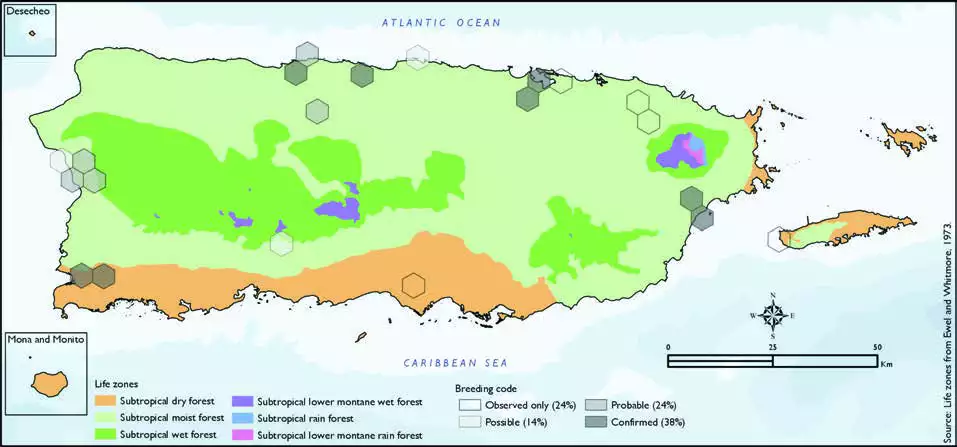West Indian Whistling-Duck
Description
The West Indian whistling duck (Dendrocygna arborea) is a whistling duck that breeds in the Caribbean. Alternative names are black-billed whistling duck and Cuban whistling duck.
The West Indian whistling duck is the largest and darkest of the whistling ducks. With a length of 48 to 58 cm (19 to 23 in) and female weighs from 800 to 1,320 g (1.76 to 2.91 lb) and male weights from 760 to 1,240 g (1.68 to 2.73 lb), this species is about the size of a mallard. It has a long black bill, long head and longish legs. It has a pale foreneck and light brown face. The crown, back, breast and wings are dark brown to black, and the rest of the underparts are white with heavy black markings.
Threats
The West Indian whistling duck has suffered extensive hunting for its eggs and for sport. Wetlands are a very limited habitat in the Caribbean, with continuing conversion for development and agriculture. More than 50_ of remaining wetlands are seriously degraded by the cutting of mangroves and swamp-forest, pollution (especially over-use of pesticides1) and natural catastrophes such as droughts and hurricanes. Predation is inadequately documented but may be a factor.
Distribution & Habitat
The West Indian Whistling-Duck occurs through The Bahamas,
Greater Antilles, the Virgin
and Cayman Islands, Antigua,
and Barbuda (Raffaele and
others 1998). Nonetheless, it is
uncommon to rare throughout
most of its distribution range
(Raffaele and others 1998).
In Puerto Rico, it has been
observed in ponds and lagoons
at the municipalities of Cabo
Rojo, Añasco, Yabucoa, Ceiba,
Fajardo, and Humacao (Del
Moral 2001, Lewis 2003, Silvestre
2003), as well as in the Caño
Tiburones Natural Reserve,
Cayures pond and Lagunas
de Coloso in Aguada, and the
Cucharillas Lagoon in Cataño
(Bonilla and others 1992,
Rodríguez-Mojica 2003). It also occurs on Culebra and Vieques,
in the latter being an extremely
rare, possible breeder (Gemmill
2015). This species habitat
includes mangroves, swamps,
lagoons, palm savannas (Oberle
2018, Raffaele and others 1998),
and sometimes agricultural
fields (Biaggi 1997). The atlas
fieldwork yielded a total of 62
records within 21 hexagons or 4
percent of the 479 total hexagons
(see map). Of the 21 hexagons
where this species was found,
breeding met the atlas definition
of confirmed in 38 percent
(eight) of the hexagons, probable
in 24 percent (five), and possible
in 14 percent (three), while
the species was observed in 24
percent (five) of the hexagons
but without evidence of breeding
(see map). West Indian Whistling-Duck distribution. The map shows the highest breeding code by hexagon and overlaying the ecological life
zones in Puerto Rico. Note: percentages may not total 100 due to rounding. 29West Indian Whistling-Duck/Chiriría Caribeña

Breeding Habits
The West Indian Whistling-Ducks nest is made of dry
leaves, twigs, and other loose
vegetation, and is usually placed
on a cluster of palm fronds or a
tree cavity (Biaggi 1997, Raffaele
and others 1998). Previously
published reports indicate that
breeding occurs throughout the
year, although it seems to vary
depending on rainfall (Raffaele
and others 1998). Atlas results
show that this species breeding
season extends throughout the
year, with the most evidence
of breeding activity during
August, and to a lesser extent in April, May, and December (see
chart). Results show evidence of
breeding activity for this species
mostly in the lowlands within the
subtropical moist forest life zone
(88 percent of the hexagons)
and less frequently within the
subtropical dry forest life zone
(13 percent of the hexagons)
(see table and map).
Conservation
The current population trend of the West Indian Whistling-
Duck is described as increasing
at a moderate rate, thanks to
conservation efforts across its
range (Levesque and Sorenson 2012). Some populations have
suffered declines mostly due
to habitat destruction, hunting,
and introduced predators
(Raffaele and others 1998). This
species is currently listed as
vulnerable by the IUCN (BirdLife
International 2016). In Puerto
Rico, the West Indian Whistling-
Duck is classified as critically
endangered (PRDNER 2016) and
has a protected habitat in land
of about 16 percent or 61 km2 of the total area covered by
the hexagons where evidence
of breeding was found for this
species (383 km2).
Related Species
Family:
duck